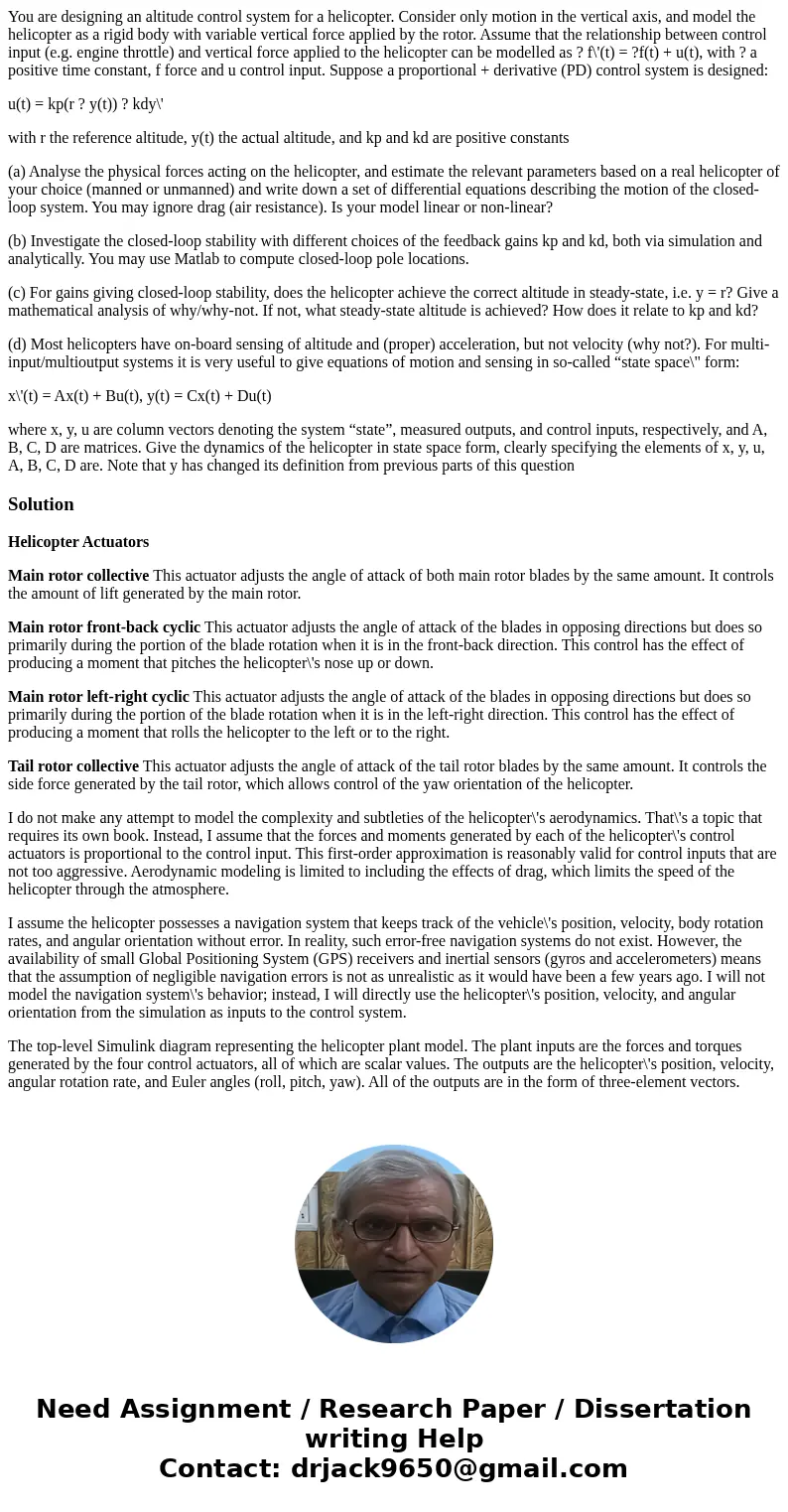You are designing an altitude control system for a helicopte
You are designing an altitude control system for a helicopter. Consider only motion in the vertical axis, and model the helicopter as a rigid body with variable vertical force applied by the rotor. Assume that the relationship between control input (e.g. engine throttle) and vertical force applied to the helicopter can be modelled as ? f\'(t) = ?f(t) + u(t), with ? a positive time constant, f force and u control input. Suppose a proportional + derivative (PD) control system is designed:
u(t) = kp(r ? y(t)) ? kdy\'
with r the reference altitude, y(t) the actual altitude, and kp and kd are positive constants
(a) Analyse the physical forces acting on the helicopter, and estimate the relevant parameters based on a real helicopter of your choice (manned or unmanned) and write down a set of differential equations describing the motion of the closed-loop system. You may ignore drag (air resistance). Is your model linear or non-linear?
(b) Investigate the closed-loop stability with different choices of the feedback gains kp and kd, both via simulation and analytically. You may use Matlab to compute closed-loop pole locations.
(c) For gains giving closed-loop stability, does the helicopter achieve the correct altitude in steady-state, i.e. y = r? Give a mathematical analysis of why/why-not. If not, what steady-state altitude is achieved? How does it relate to kp and kd?
(d) Most helicopters have on-board sensing of altitude and (proper) acceleration, but not velocity (why not?). For multi-input/multioutput systems it is very useful to give equations of motion and sensing in so-called “state space\" form:
x\'(t) = Ax(t) + Bu(t), y(t) = Cx(t) + Du(t)
where x, y, u are column vectors denoting the system “state”, measured outputs, and control inputs, respectively, and A, B, C, D are matrices. Give the dynamics of the helicopter in state space form, clearly specifying the elements of x, y, u, A, B, C, D are. Note that y has changed its definition from previous parts of this question
Solution
Helicopter Actuators
Main rotor collective This actuator adjusts the angle of attack of both main rotor blades by the same amount. It controls the amount of lift generated by the main rotor.
Main rotor front-back cyclic This actuator adjusts the angle of attack of the blades in opposing directions but does so primarily during the portion of the blade rotation when it is in the front-back direction. This control has the effect of producing a moment that pitches the helicopter\'s nose up or down.
Main rotor left-right cyclic This actuator adjusts the angle of attack of the blades in opposing directions but does so primarily during the portion of the blade rotation when it is in the left-right direction. This control has the effect of producing a moment that rolls the helicopter to the left or to the right.
Tail rotor collective This actuator adjusts the angle of attack of the tail rotor blades by the same amount. It controls the side force generated by the tail rotor, which allows control of the yaw orientation of the helicopter.
I do not make any attempt to model the complexity and subtleties of the helicopter\'s aerodynamics. That\'s a topic that requires its own book. Instead, I assume that the forces and moments generated by each of the helicopter\'s control actuators is proportional to the control input. This first-order approximation is reasonably valid for control inputs that are not too aggressive. Aerodynamic modeling is limited to including the effects of drag, which limits the speed of the helicopter through the atmosphere.
I assume the helicopter possesses a navigation system that keeps track of the vehicle\'s position, velocity, body rotation rates, and angular orientation without error. In reality, such error-free navigation systems do not exist. However, the availability of small Global Positioning System (GPS) receivers and inertial sensors (gyros and accelerometers) means that the assumption of negligible navigation errors is not as unrealistic as it would have been a few years ago. I will not model the navigation system\'s behavior; instead, I will directly use the helicopter\'s position, velocity, and angular orientation from the simulation as inputs to the control system.
The top-level Simulink diagram representing the helicopter plant model. The plant inputs are the forces and torques generated by the four control actuators, all of which are scalar values. The outputs are the helicopter\'s position, velocity, angular rotation rate, and Euler angles (roll, pitch, yaw). All of the outputs are in the form of three-element vectors.

 Homework Sourse
Homework Sourse